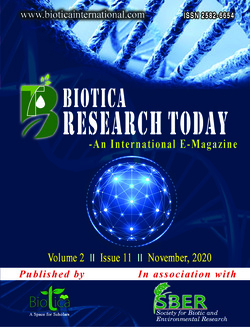
Insect Venom of Social Hymenoptera
Devi, M.*
Dept. of Agricultural Entomology, MIT College of Agriculture and Technology, Musiri, Tamil Nadu (621 211), India
K. Indirakumar
Central Silk Board, Tura, West Garo Hills, Meghalaya (794 101), India
DOI: NIL
Keywords: Ant bees, Insect, Venom, Wasp
Abstract
The venoms of the social Hymenoptera evolved to be used as defensive tools to protect the colonies of these insects from the attacks of predators. Generally they do not cause lethal effects but cause mainly inflammatory and/or immunological reactions in the victims of their stings. However, sometimes it is also possible to observe the occurrence of systemic effects like respiratory and/or kidney failure. Meanwhile, the venoms of solitary Hymenoptera evolved mainly to cause paralysis of the preys in order to permit egg laying on/within the prey’s body; thus, some components of these venoms cause permanent/ transient paralysis in the preys, while other components seem to act preventing infections of the food and future progenies. In addition to these peptides, the Hymenopteran venoms also may contain a few neurotoxins that target Na+ and/or Ca+2 channels or even the nicotinic ACh receptor.
Downloads
not found
Reference
Orivel, J., Dejean, A., 2001. Comparative effect of the venoms of ants of the genus Pachycondyla (Hymenoptera Ponerinae). Toxicon., 39: 195–201.
Palma, M.S., Brochetto-Braga, M.R., 1993. Biochemical variability between venoms from different honeybee (Apis mellifera) races. Comparat. Biochem. Physiol., 106: 423–427.
